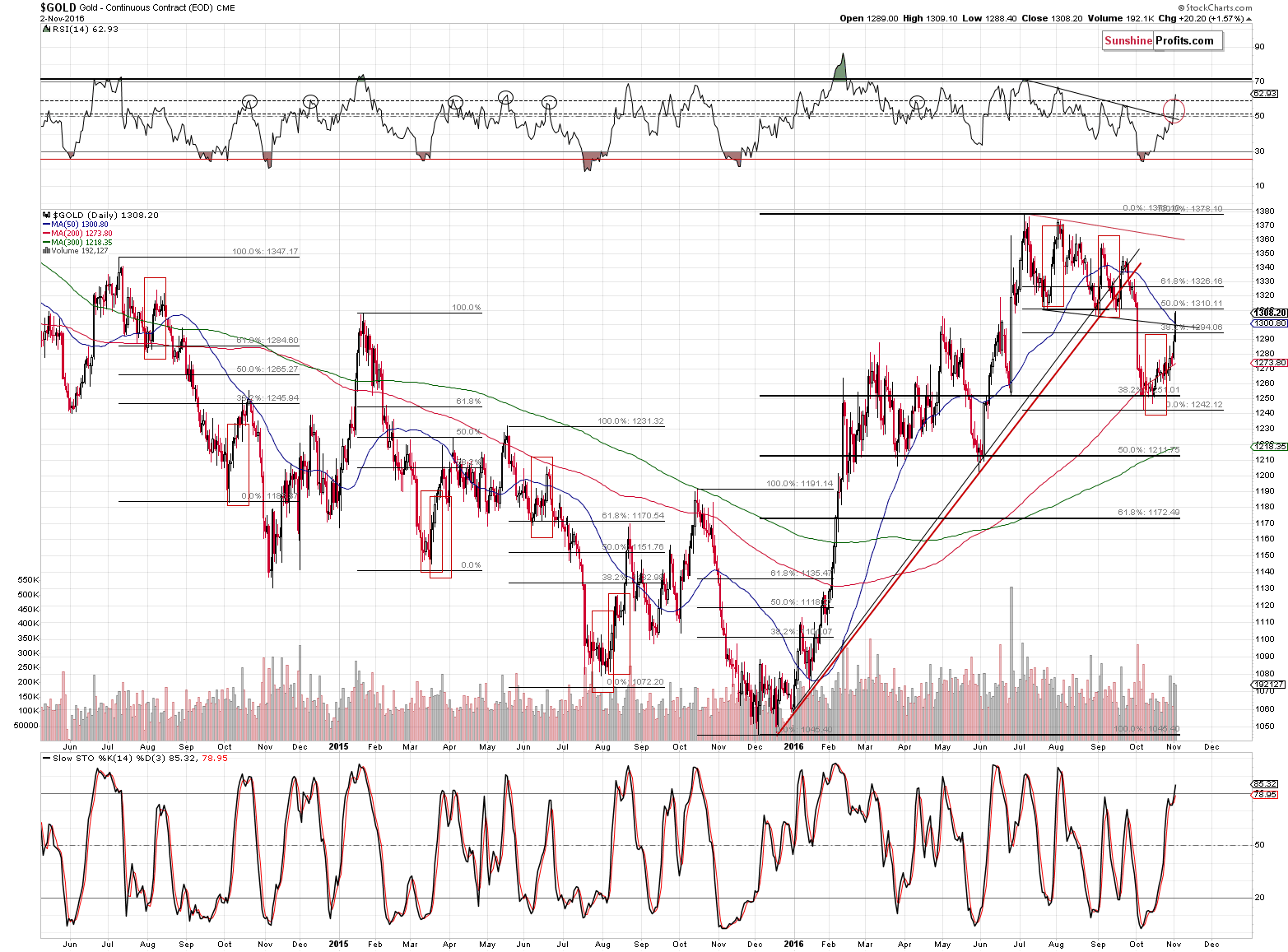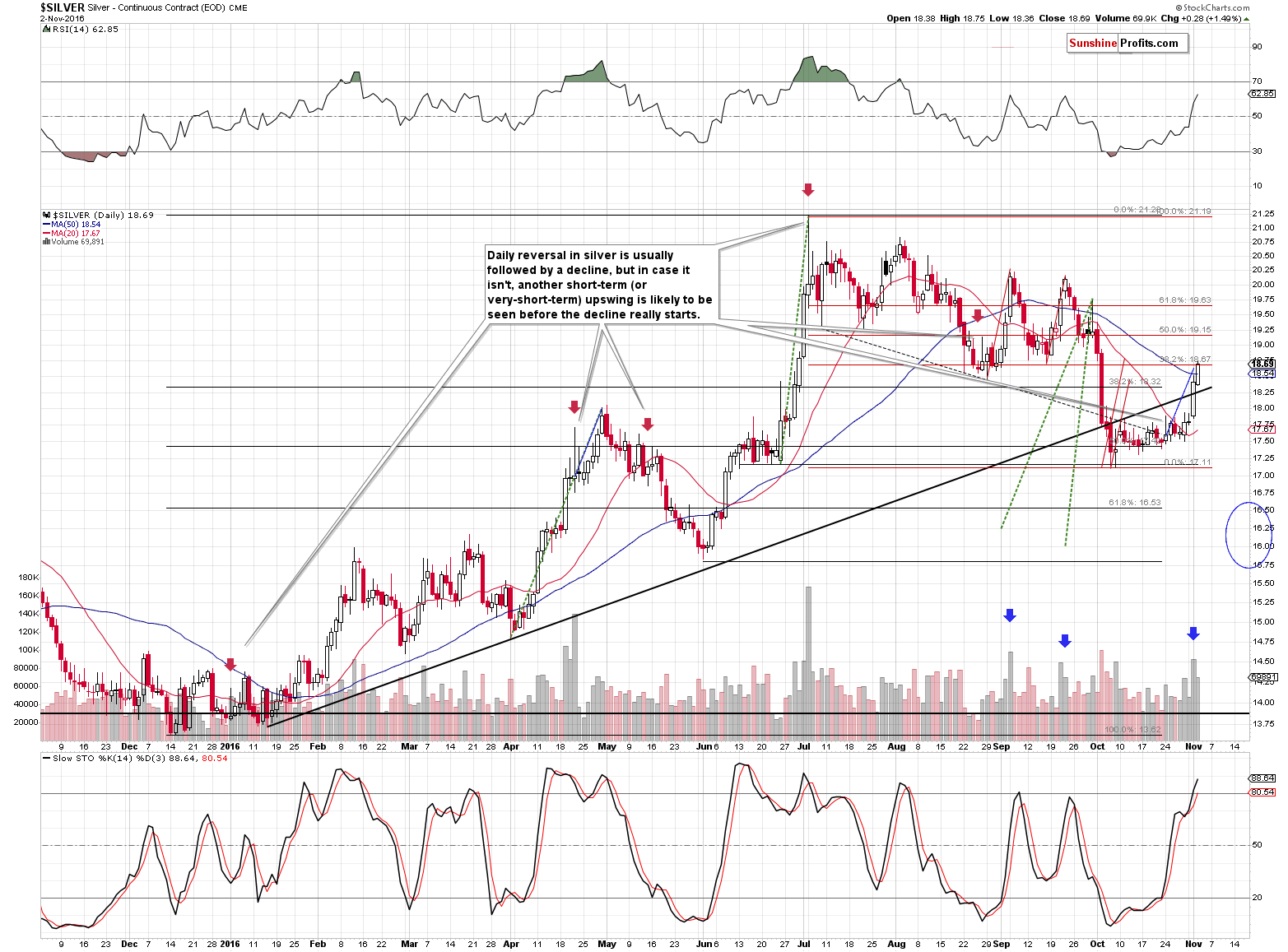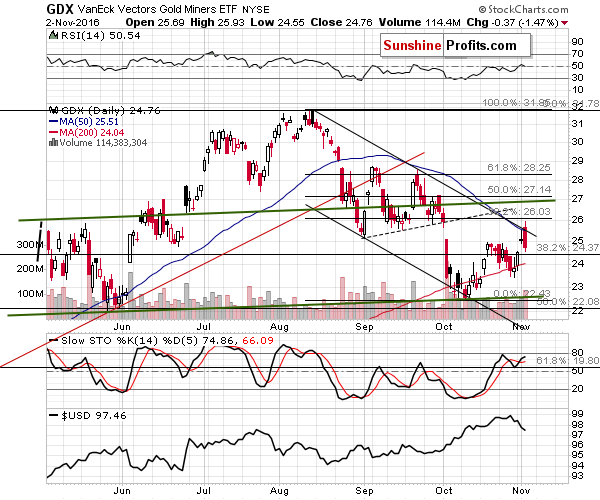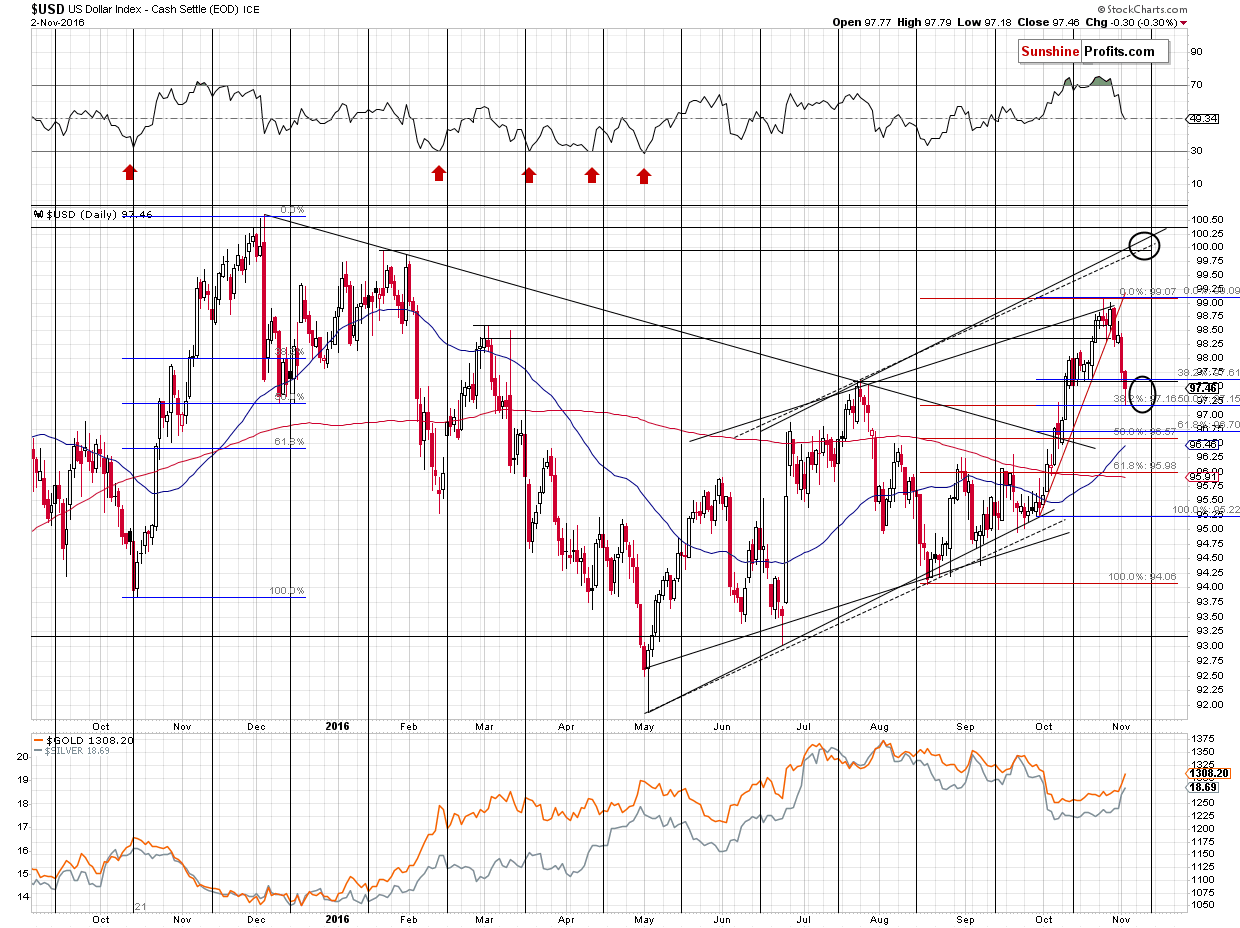Briefly: In our opinion, (full) speculative short positions in gold, silver and mining stocks are justified from the risk/reward perspective.
Gold, silver and mining stocks soared initially yesterday, but finally ended the session only a bit higher (gold and silver) or even lower (mining stocks). What can we infer from this kind of behavior?
That a top is either in or extremely close. The invalidation of a breakout in mining stocks is a very bearish sign on it’s own and the fact that it happened in a clear way despite a move higher in gold is even more bearish. Silver’s relatively good performance is not making the situation bullish – silver tends to outperform in the final parts of a given upswing, thus it serves as a bearish sign.
Let’s take a closer look at the charts (charts courtesy of http://stockcharts.com).

In yesterday’s alert, we wrote the following:
Gold rallied yesterday, moving close to several important resistance levels. Gold was only about $1 away from the 38.2% Fibonacci retracement level and at the moment of writing these words, gold is trading at $1,295 and the intra-day high (so far) is $1,298 – very close to the $1,300 resistance. The latter is based on the July and September lows and the declining line based on them. The 50-day moving average is also just $2 above $1,300, so it’s making the $1,300 level even more likely to stop the rally.
Gold moved above the $1,300 level, but only temporarily – it finally closed below $1,297 (based on kitco.com’s closing prices – the prices provided by stockcharts.com might not be as reliable at this time) and at the moment of writing these words, gold is trading at about $1,294 – clearly well below $1,300.
The brief breakout above the mentioned resistance levels was therefore invalidated and the implications are bearish.

We can say something similar about silver. In yesterday’s alert, we wrote the following:
The above silver chart is full of bearish signs, even though a daily rally appears rather encouraging at the first sight. In addition to the discussed outperformance of gold, we can see the following:
- Rally on huge volume after at least several days of rallying (marked with blue arrows – similar sessions in September meant local tops).
- Size of the rally after the initial reversal (marked with blue lines) is almost identical with the one that we saw in April.
- Stochastic indicator is above 80 and in the case of several previous rallies either this level or its proximity were something that we saw very close to local tops.
- Silver moved to the 50-day moving average and – since silver moved to $18.63 in today’s pre-market trading – it moved very close the the 38.2% Fibonacci retracement level (both levels are likely to keep the rally in check).
Yes, silver moved back above the rising support line based on the January and April lows, but silver is known for its fake breakouts, so we don’t view this development as significant (especially since there was no breakout in the case of mining stocks).
After we wrote the above, silver moved only a little higher and then declined – to about $18.46 according to kitco.com’s closing prices (and it’s currently trading at $18.16). The breakouts above the 38.2% Fibonacci retracement and the 50-day moving average were invalidated and the implications are bearish.

The most important bearish sings, however, can be seen on the above chart featuring gold stocks and silver stocks. Yesterday, we wrote that Tuesday’s intra-day high was right at the declining resistance line – the upper border of the declining trend channel. Since there was no breakout and the candlestick took the form of a reversal gravestone doji, the implications of the Tuesday’s upswing were bearish.
What’s even more bearish than a move to the resistance line and a daily reversal? Invalidation of an important breakout despite a rally in gold – and that’s exactly what we saw yesterday. The volume was high (in both absolute and relative terms), so the bearish sign is even more profound.
Even without silver’s confirmation and regardless of gold and the USD reaching their targets, the action in mining stocks alone is so bearish that it would likely justify having short positions on its own.
Speaking of the USD Index, let’s take a look at its chart.

The USD Index moved temporarily to 97.18, but ultimately closed at 97.40 – which is very much in tune with our target area.
In the Oct. 31 alert, we wrote the following:
The USD Index declined on Friday, moving below the March highs and the rising red support line. The breakdowns were not confirmed, but they are already bearish for the short term. Consequently, we added an alternative target area – if the USD Index is indeed starting to move lower, then we may see the bottom close to the 97.25 – 97.50 area. Please note that the cyclical turning point is about 2 weeks away and it’s quite likely to correspond to a reversal. The short-term implications for the precious metals sector are bullish.
Let’s keep in mind that the turning points work on a near-to basis and given the major news that’s going to be released in early November (we’ll know who’s going to be the next U.S. President), it could be the case that the turnaround takes place close to the announcement – perhaps shortly before it, if the polls clearly point to a certain outcome.
The above could also be the reason due to which precious metals will not decline right away – uncertainty fuels the PMs and there’s no doubt that it will remain in place before the next U.S. President is chosen. When would the turnaround be seen? Probably soon – and it could be seen before the elections due to the way polls could shape – but we’ll wait for additional confirmations (for instance from silver) before opening another speculative position.
In today’s alert we would like to discuss the similarity of the current decline to the one seen in late 2015. After all, the rallies that preceded both of them were similar – these were the only 2 rallies that pushed the RSI above 70. The 2015 rally was more volatile, but on a relative basis we see that the bottom was formed when the USD moved below the 38.2% Fibonacci retracement level. To be precise – it ended once the USD reached the 50% retracement. Since the 2 rallies are similar, the declines could be similar as well. Applying this analogy to the current situation, suggests looking for a bottom in the proximity of the 38.2% or 50% retracements.
Please note that while the end of the rally is clear, it’s not clear what we should take into account as its beginning – the session at the end of September, from which the rally accelerated, or the August bottom. Using the former provides us with levels marked in blue, and the latter provides us with levels marked in red. Interestingly, the 38.2% red retracement corresponds to the 50% blue retracement and that’s exactly where yesterday’s intra-day bottom was. This makes it quite likely that the final bottom was indeed in and if it wasn’t, that it’s not far away.
Summing up, based on the combination of signs that a bottom in the USD Index is in or close to being in, the outperformance of silver and invalidations of breakouts in the case of gold and mining stocks (and clear underperformance of the latter), it seems that the risk to reward ratio now favors speculative short positions in gold, silver and mining stocks.
The period before the U.S. elections could be volatile, but based on the combination of the mentioned factors, it still seems that a speculative position is now justified. The polls are close to a tie and they are publicly known, thus there will likely be little surprise just before the election. In the case of the Brexit vote, there was a huge surprise, as Bremain was the very likely outcome and the markets were surprised, to say the least. Investors, who are particularly risk averse, may want to consider limiting the size of the position before the elections, though. Still, if it wasn’t for the upcoming elections and the related uncertainty, we would have probably increased the size of the current short position even further (based on what we saw in mining stocks).
As always, we will keep you – our subscribers – updated.
To summarize:
Trading capital (supplementary part of the portfolio; our opinion): Short positions (100% of the full position) in gold, silver and mining stocks are justified from the risk/reward perspective with the following entry prices, stop-loss orders and initial target price levels:
- Gold: initial target price: $1,006; stop-loss: $1,331, initial target price for the DGLD ETN: $73.19; stop-loss for the DGLD ETN $41.89
- Silver: initial target price: $13.12; stop-loss: $19.23, initial target price for the DSLV ETN: $39.78; stop-loss for the DSLV ETN $18.74
- Mining stocks (price levels for the GDX ETF): initial target price: $9.34; stop-loss: $27.32, initial target price for the DUST ETF: $297; stop-loss for the DUST ETF $27.87
In case one wants to bet on junior mining stocks' prices (we do not suggest doing so – we think senior mining stocks are more predictable in the case of short-term trades – if one wants to do it anyway, we provide the details), here are the stop-loss details and initial target prices:
- GDXJ ETF: initial target price: $14.13; stop-loss: $47.41
- JDST ETF: initial target price: $245; stop-loss: $18.59
Long-term capital (core part of the portfolio; our opinion): No positions
Insurance capital (core part of the portfolio; our opinion): Full position
Plus, you might want to read why our stop-loss orders are usually relatively far from the current price.
Please note that a full position doesn’t mean using all of the capital for a given trade. You will find details on our thoughts on gold portfolio structuring in the Key Insights section on our website.
As a reminder – “initial target price” means exactly that – an “initial” one, it’s not a price level at which we suggest closing positions. If this becomes the case (like it did in the previous trade) we will refer to these levels as levels of exit orders (exactly as we’ve done previously). Stop-loss levels, however, are naturally not “initial”, but something that, in our opinion, might be entered as an order.
Since it is impossible to synchronize target prices and stop-loss levels for all the ETFs and ETNs with the main markets that we provide these levels for (gold, silver and mining stocks – the GDX ETF), the stop-loss levels and target prices for other ETNs and ETF (among other: UGLD, DGLD, USLV, DSLV, NUGT, DUST, JNUG, JDST) are provided as supplementary, and not as “final”. This means that if a stop-loss or a target level is reached for any of the “additional instruments” (DGLD for instance), but not for the “main instrument” (gold in this case), we will view positions in both gold and DGLD as still open and the stop-loss for DGLD would have to be moved lower. On the other hand, if gold moves to a stop-loss level but DGLD doesn’t, then we will view both positions (in gold and DGLD) as closed. In other words, since it’s not possible to be 100% certain that each related instrument moves to a given level when the underlying instrument does, we can’t provide levels that would be binding. The levels that we do provide are our best estimate of the levels that will correspond to the levels in the underlying assets, but it will be the underlying assets that one will need to focus on regarding the signs pointing to closing a given position or keeping it open. We might adjust the levels in the “additional instruments” without adjusting the levels in the “main instruments”, which will simply mean that we have improved our estimation of these levels, not that we changed our outlook on the markets. We are already working on a tool that would update these levels on a daily basis for the most popular ETFs, ETNs and individual mining stocks.
Our preferred ways to invest in and to trade gold along with the reasoning can be found in the how to buy gold section. Additionally, our preferred ETFs and ETNs can be found in our Gold & Silver ETF Ranking.
As always, we'll keep you - our subscribers - updated should our views on the market change. We will continue to send out Gold & Silver Trading Alerts on each trading day and we will send additional Alerts whenever appropriate.
The trading position presented above is the netted version of positions based on subjective signals (opinion) from your Editor, and the Tools and Indicators.
As a reminder, Gold & Silver Trading Alerts are posted before or on each trading day (we usually post them before the opening bell, but we don't promise doing that each day). If there's anything urgent, we will send you an additional small alert before posting the main one.
=====
Latest Free Trading Alerts:
Yesterday, the FOMC members leaved interest rates unchanged. What does it mean for the gold market?
November FOMC Meeting and Gold
S&P 500 index slightly extended its short-term downtrend yesterday. Will it bounce off 2,100 mark? Or continue lower following a breakout below two-month-long consolidation?
Stock Trading Alert: S&P 500 At 2,100 Support Level - Make Or Break?
=====
Hand-picked precious-metals-related links:
BRIEF-CME raises Gold, Silver maintenance margins
CME Group Metals volume shoots up 27% in October
=====
In other news:
British government must consult parliament before quitting EU, court rules
Bank of England seen holding rates as economists predict a spike in UK inflation
=====
Thank you.
Sincerely,
Przemyslaw Radomski, CFA
Founder, Editor-in-chief, Gold & Silver Fund Manager
Gold & Silver Trading Alerts
Forex Trading Alerts
Oil Investment Updates
Oil Trading Alerts



